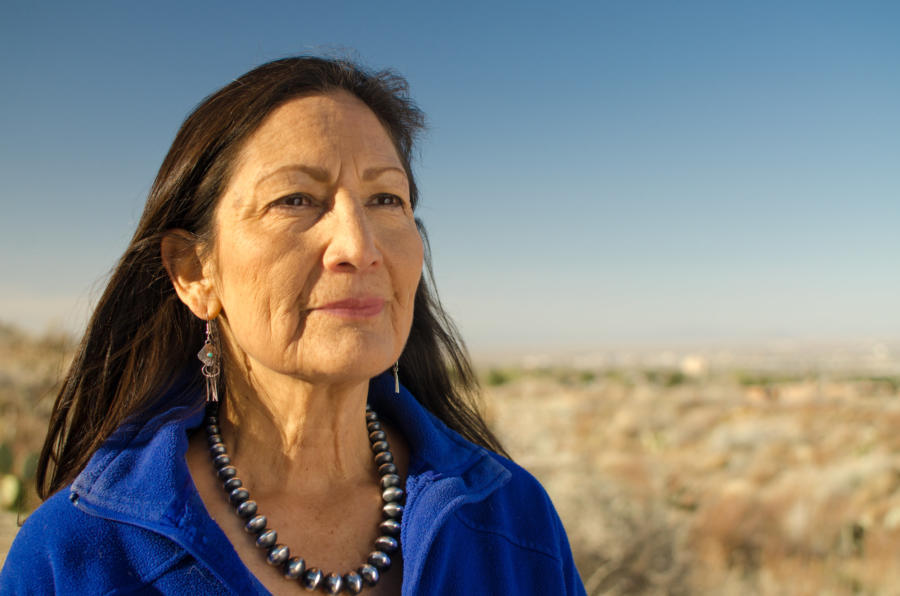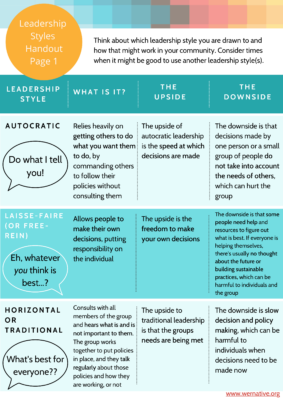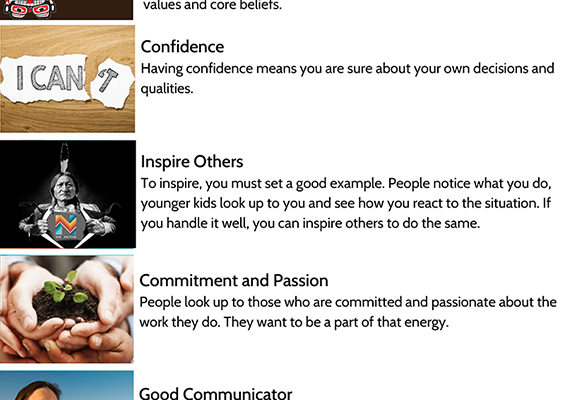Welcome, welcome, welcome! What does being an tribal leader mean to you? What does it mean to be a leader and a member of your community?
On this page, we will talk about the different types of Indigenous leaderships styles, skills, and attributes. Then, you can download some useful handouts to help you identify which leadership styles and skills you currently possess (this will change throughout your lives) and what skills you would like to further develop.

Styles of leadership
Think about which leadership style you are drawn to and how that might work in your community. Consider times when it might be good to use another leadership style(s).
Like a lot of things, we can think about leadership as a continuum, like a straight line; one extreme is on one side, while the opposite extreme is on the other.
Autocratic leadership.
On one side of the extreme there is a type of leadership that comes from the top down, where a few people make all the decisions for everyone else and expect others to follow their rules without question. This is called autocratic leadership.
Autocratic leadership.
On one side of the extreme there is a type of leadership that comes from the top down, where a few people make all the decisions for everyone else and expect others to follow their rules without question. This is called autocratic leadership.
Laissez-Faire leadership.
Now, an example of the opposite extreme would be a free-for-all style of leadership, called laissez-faire. This type of leadership, like its name suggests is pretty much a free for all. There is no one is in charge and there is very little guidance on how things are done.
Laissez-Faire leadership.
Now, an example of the opposite extreme would be a free-for-all style of leadership, called laissez-faire. This type of leadership, like its name suggests is pretty much a free for all. There is no one is in charge and there is very little guidance on how things are done.
Indigenous Leadership.
Finally, somewhere in the middle of this line is Indigenous leadership. This is where everyone works together to achieve a common goal. This is called horizontal or traditional leadership. This type of leadership often brings about equity for the group and not just those who are at the top because those who are in the middle are a part of the decision making.
Indigenous Leadership.
Finally, somewhere in the middle of this line is Indigenous leadership. This is where everyone works together to achieve a common goal. This is called horizontal or traditional leadership. This type of leadership often brings about equity for the group and not just those who are at the top because those who are in the middle are a part of the decision making.
Read this to learn more about the different styles of leadership.
Read this to learn more about the different styles of leadership.
Important leadership skills
Think about what Leadership Style you lean towards and what your skills and attributes are. It’s important to think about who you are as a leader currently, so that you can think realistically about the type of leader you want to grow into.
Leadership Skills are the gifts you have that will help you to organize and lead others to a shared goal. Examples of skills are; empathy, honesty, humility, and communication skills.
Leadership Attributes are similar to skills but are slightly different, though there can be some crossover between the two. Attributes are your characteristics, something that makes up who you are. An example of an attributes is to be labeled as funny, intelligent, or charming.
Read through these Leadership Skill & Attribute examples.

What type of leader am I?
Think about yourself as leader: an Tribal Leader. We all come to the table with different gifts; some that are obvious, some we are unsure of and some we can’t yet see. You’re here because you, or someone else, believed you were supposed to be here. Let’s start to carve the path you were meant to follow.
All leaders approach tasks in four different ways, based on how they are motivated. They will either do things for others in positive or negative ways. Or, they will do things based on their wants, either in a positive or negative way:
- You’re Positive and WILL DO what OTHERS want. You may still be working from a positive place, but this may be doing what others want you to do. Like if your family is wanting you to take music lessons, but you’re not really into it. While you may enjoy it, it’s more for them, than for you.
- You’re Negative and HAVE TO do what OTHERS want. This might be when you despise taking music lessons, but your family is making you do it. And, if you don’t continue, they may take away some privileges.
- You’re Negative about what YOU MUST DO. This might be when you despise taking music lessons, but your family would be really disappointed if you quit, so you do it anyway, but you’re not happy about it.
- You’re Positive and GET TO do what YOU want. This is where we want to get to. This is the money spot and it can take time to get to. This is when you are positively doing something that you want and are motivated to make it happen.
- You’re Positive and WILL DO what OTHERS want. You may still be working from a positive place, but this may be doing what others want you to do. Like if your family is wanting you to take music lessons, but you’re not really into it. While you may enjoy it, it’s more for them, than for you.
- You’re Negative and HAVE TO do what OTHERS want. This might be when you despise taking music lessons, but your family is making you do it. And, if you don’t continue, they may take away some privileges.
- You’re Negative about what YOU MUST DO. This might be when you despise taking music lessons, but your family would be really disappointed if you quit, so you do it anyway, but you’re not happy about it.
- You’re Positive and GET TO do what YOU want. This is where we want to get to. This is the money spot and it can take time to get to. This is when you are positively doing something that you want and are motivated to make it happen.



